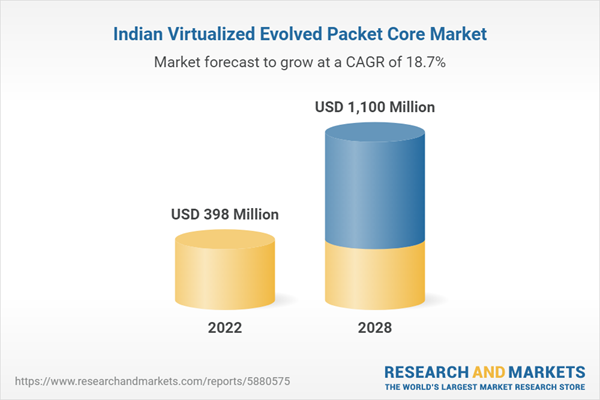Speak directly to the analyst to clarify any post sales queries you may have.
10% Free customizationThis report comes with 10% free customization, enabling you to add data that meets your specific business needs.
Furthermore, the market for Virtualized Evolved Packet Core solutions is being propelled by an unprecedented surge in the number of devices, users, and applications. Furthermore, as the demand for additional bandwidth to support mobile networks grows, telecommunications companies are looking for more cost-effective solutions. The vEPC market may have significant growth potential in the coming years. The willingness of telco operators to invest in the virtualized framework is largely responsible for the opportunity growth. Furthermore, the rapid increase in the volume of data carried by cellular networks has been driven primarily by consumer demand for video and a shift in business practises toward the use of cloud services. The commercialization of 5G services in industries such as private 5G and the availability of unlicensed and shared spectrum in India are expected to have an impact on the future direction of the vEPC market.
Network Functions Virtualization (NFV), which virtualizes Evolved Packet Core functions, implements a framework for voice and data processing and switching in mobile networks known as a Virtual Evolved Packet Core (vEPC) (EPC). The vEPC framework has been used in 4G LTE mobile networks, and the upcoming 5G network architecture would heavily rely on it as well. Moreover, the complex network administration and limited end-user functionality are present in the 2G and 3G network topologies where speech and data processing and switching are performed through two separate sub-domains which would drive the Virtual Evolved Packet Core. The introduction of EPC with 4G enabled mobile customers to have 'always on' internet connectivity while also simplifying management for mobile network operators. Voice and data were combined on the same backbone Internet Protocol (IP) service architecture by EPC. Installing an EPC, on the other hand, necessitated a costly infrastructure of proprietary hardware and software. By transferring its operations to the software domain, Network Functions Virtualization enables the EPC to run on low-cost Commercial Off-The-Shelf (COTS) servers.
Development of 5G infrastructure
There have been numerous new technological developments, such as 5G spectrum in the telecommunications sector. The usage of technologies like IoT is prompting MNOs to construct 5G infrastructure because of the rise in data traffic. Faster data transfer and on-demand network service provisioning will be possible with 5G. MNOs throughout the world are therefore anticipated to deploy vEPC to improve their networks and increase their network capacity effectively. In addition, there have been numerous new technological developments, including 5G in the telecommunications sector. The usage of technologies like IoT is prompting MNOs to construct 5G infrastructure due to an increase in data traffic. Faster data transfer and on-demand network service provisioning will be possible due to 5G. MNOs are therefore required to deploy vEPC to improve their networks so that radio resources can be used effectively and network capacity may be increased. Installing an EPC, on the other hand, necessitate a costly infrastructure of proprietary hardware and software. By transferring its operations to the software domain, Network Functions Virtualization enables the EPC to run on low-cost Commercial Off-The-Shelf (COTS) servers.
Market Segmentation
India Virtualized Evolved Packet Core market is segmented by component type, end user and use. Based on component type, the market is further segmented into solution and service. Based on end user, the market is further divided into telecom operator and enterprise. The use market is segmented into Long Term Evolution (LTE), Voice Over LTE (VoLTE), and Voice over Wi-Fi (VoWiFi), Broadband Wireless Access (BWA), Internet of Things (IoT) and Machine to Machine (M2M), Mobile Private Networks (MPN’s) and Mobile Virtual Network Operators (MVNO’s)Market Player
Major market players in the India Virtualized Evolved Packet Core Market are Affirmed Networks India, Ericsson Communications Limited, Huawei Technologies India Private Limited, Mavenir India Information Technology Private Limited, ZTE Corporation, Athonet, Cisco Systems (India) Private Limited, Nec Corporation India Private Limited, Nokia Corporation, Samsung Electronics Co, Ltd India.Report Scope:
In this report, the India Virtualized Evolved Packet Core market has been segmented into the following categories, in addition to the industry trends which have also been detailed below:India Virtualized Evolved Packet Core Market, By Component Type:
- Solution
- Service
India Virtualized Evolved Packet Core Market, By End User:
- Telecom Operator
- Enterprise
India Virtualized Evolved Packet Core Market, By Use:
- Long Term Evolution (LTE)
- Voice Over LTE (VoLTE)
- Voice over Wi-Fi (VoWiFi)
- Broadband Wireless Access (BWA)
- Internet of Things (IoT) and Machine to Machine (M2M)
- Mobile Private Networks (MPN’s)
- Mobile Virtual Network Operators (MVNO’s)
India Virtualized Evolved Packet Core Market, By Region:
- East India
- West India
- North India
- South India
Competitive Landscape
Company Profiles: Detailed analysis of the major companies present in the India Virtualized Evolved Packet Core market.Available Customizations:
India Virtualized Evolved Packet Core market report with the given market data, the publisher offers customizations according to a company's specific needs.This product will be delivered within 1-3 business days.
Table of Contents
Companies Mentioned
- Affirmed Networks India.
- Ericsson Communications Limited
- Huawei Technologies India Private Limited
- Mavenir India Information Technology Private Limited
- ZTE Corporation
- Athonet
- Samsung Electronics Co, Ltd. India
- Nec Corporation India Private Limited
- Cisco Systems (India) Private Limited
- Nokia Corporation
Table Information
| Report Attribute | Details |
|---|---|
| No. of Pages | 72 |
| Published | September 2023 |
| Forecast Period | 2022 - 2028 |
| Estimated Market Value ( USD | $ 398 Million |
| Forecasted Market Value ( USD | $ 1100 Million |
| Compound Annual Growth Rate | 18.7% |
| Regions Covered | India |
| No. of Companies Mentioned | 10 |









